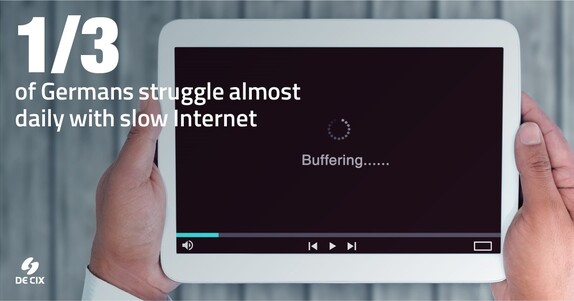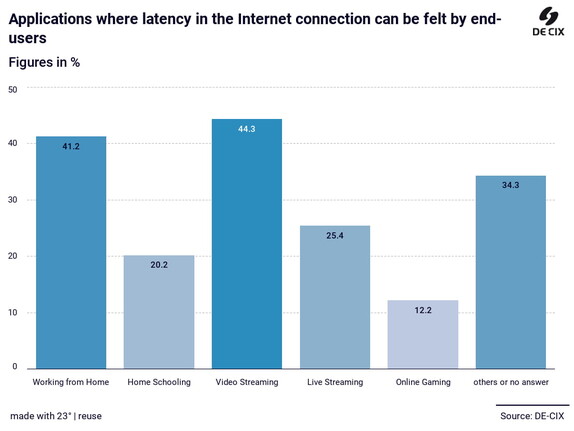More than a third of Germans experience Internet delays at home several times a week – even daily
Consumers blame poor regional network infrastructure and excessive network utilization

More than a third of Germans experience Internet delays at home several times a week – even daily
Consumers blame poor regional network infrastructure and excessive network utilization
Frankfurt am Main, 18 March 2021. One year after the first Corona lockdown in Germany, DE-CIX, the operator of the world's largest1 Internet Exchange in Frankfurt am Main, takes stock of the digitalization process. A recent representative online survey*, conducted by CIVEY on behalf of DE-CIX, found that 33.5 percent of German consumers experience delays in Internet use at home several times a week – even daily. Young adults, professionals working from home, and families with children are the most likely to experience these Internet problems. Users usually look outside their own households for the responsibility for delays.
Everyone knows at least one of these problems: jumpy video conference transmissions during distance learning or an important meeting, movies on livestreaming platforms that buffer endlessly because the Internet has got the hiccups again, or online gaming parties that come to an abrupt end because of a slow Internet connection. Internet delays can be very frustrating – especially when you actually need reliable Internet.
The recent DE-CIX study shows that 33.5 percent of German users experience these delays when using digital applications several times a week or even daily. Only 11.6 percent of the study participants said they never had problems with delays. In particular, it is the age groups “18 to 29 years” (45 percent) and “30 to 39 years” (40 percent) who perceive delays in their everyday Internet life most strongly and suffer with slow Internet at least several times a week, up to every day. This applies above all to those who are dependent on the home Internet connection for their professional activities (41 percent), as well as for their school-age children making use of distance learning options (20 percent). Thus, 42 percent of German households with at least one child notice delays from several times a week to daily, and do so more readily than households without children (29 percent).
But it is not only in the professional and educational context that consumers are experiencing problems with their Internet: Delays are also a very frustrating and disruptive factor for digital leisure activities such as video streaming (44 percent), live streaming of sporting events (25.4 percent), and online gaming (12 percent). “This study reveals the weak points of digitization! In the future, an even stronger expansion of all system-relevant elements of the Internet and the digital supply chain is unavoidable. We need more data centers that are as close as possible to the end user. This is the only way to guarantee more connectivity and a robust roll-out of the digital last mile to households. It is no longer acceptable for connectivity issues to be a barrier to working from home or distance learning. The Internet is a complex system and an interplay of many parties, in which everyone must make their contribution every day, and must also think ahead in a strategically innovative way,” says Dr. Thomas King, CTO at DE-CIX, about the results of the study.

The increased perception regarding Internet problems arising when working from home (or during distance learning) and during video streaming is mainly due to the fact that these activities have been used more frequently and more intensively in the last year. Accordingly, consumers have developed a greater awareness of the reliability of their Internet. But the question is: Do they also know what causes delays? Consumers look for accountability outside their own sphere of influence. The majority agree that the problem must be the inadequate regional expansion of the network infrastructure (57 percent) or the overloading of their network (53 percent). Causes that they themselves can (more or less) influence – such as inferior routers or outdated devices – are mentioned comparatively less often (12 percent).
But what is the cause of such delays? Dr. Thomas King on this: “Within the Internet ecosystem, Internet Exchanges such as DE-CIX act as an intermediary between three different types of networks. For example, when watching a movie via Netflix, the user’s device makes a request over the network of the user’s Internet service provider (such as the Vodafone end-customer network), which is routed through an Internet Exchange directly to the Netflix network. There, the Netflix servers process the request and send the requested film in the form of data packets back to the end-user. The time that passes during this round trip is called “latency”. The further the target network – in this case, Netflix – is from the user, the higher the latency and the more noticeable the delays.”
For an optimal performance level, the latency should ideally not exceed 15 milliseconds. However, to ensure this, content and applications must be hosted as close as possible to the end user, at the so-called “edge” of the Internet – for live streaming in HD/4K, a distance of less than 1,200 kilometers would be ideal.
“We are already using applications that require very low, sometimes single-digit latencies – meaning delays of less than 10 milliseconds. For an optimal user experience, as well as to ensure the highest security and performance for certain applications in the areas of eHealth, mobility or even finance, we must continue to expand the digital infrastructures and increasingly rely on decentralized data centers close to end-users. In scenarios such as autonomous driving, the lowest possible latency is critical to safety and a prerequisite for implementation. To ensure safe road traffic, there must then be a dedicated local data center or Internet Exchange at practically every interchange or rest stop,” concludes Dr. Thomas King.
1According to accumulated data throughput in 2020
*Methodology
Online survey conducted by CIVEY on behalf of DE-CIX
Survey Period: 17 February to 24 February 2021
Question 1: How often do you experience delays when using the Internet (e.g. when livestreaming)?
Question 2: When do you experience delays during Internet usage?
Question 3: What do you think is the reason for delays when you use the Internet?